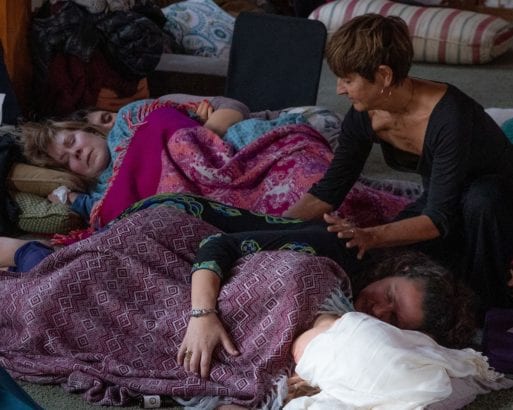
Students participate in an exercise at a 2018 Flat Rock, NC, death doula training program hosted by the Conscious Dying Institute
Conscious dying — being aware, awake and accepting of what is happening at end of life and in the moment of one’s death — is not a defined practice with precepts that can be followed to ensure a smooth transition to whatever awaits on the other end of life. It may, however, bring peace by allowing a person to die on his or her own terms while motivating spiritual healing for the individual and those left behind.
For myriad reasons and in just as many ways, a move toward returning dying to a more sacred and communal realm is beginning to gain traction in America and challenging a culture of death defiance in the process.
While many Eastern cultures and religions view death as a natural function of life, a necessary means of keeping cycles of birth and rebirth moving, Western society is set up much differently. Life and death are treated as mutually exclusive — to move closer to one is to move further away from the other.
Modern medicine can deepen this dynamic in its effort to keep humans alive as long as possible and at any cost, while the funeral industry tidily sweeps away any evidence of death once it has occurred, so the grieving need not be troubled by existential fears and unanswered questions. In the absence of tangible information and without a real connection to dying, however, our fears around death only grow, and the sacredness of a natural and important stage of life is lost over time.
Still, a shift in consciousness seems to be occurring as more people of the baby boomer generation — who account for a vast segment of the population — seek a dying experience that is different from the deaths of their parents and have begun to consider available alternatives. Organizations that provide end-of-life resources and training programs are reporting increased interest in hospice and palliative care services, death doulas and midwives, and home funerals that provide loved ones an opportunity to sit with a body and ritualize their good-byes.
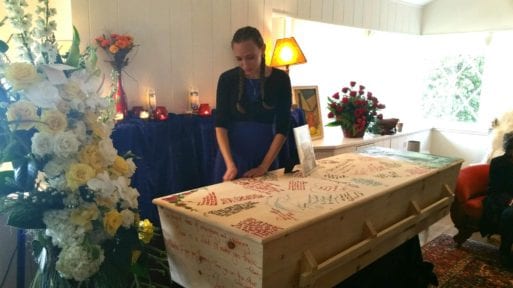
Organizations are reporting increased interest in hospice and palliative care services, death doulas and midwives, and home funerals that provide loved ones an opportunity to ritualize death.
Credit: Sacred Crossings
At the head of this trend are people who wish to learn how they might work with end-of-life patients following the diagnosis of a terminal illness or sit at the bedside and support grieving family members. While professionals who operate end-of-life care certificate programs acknowledge the supply of service providers still outstrips demand, they note a growing receptivity among clients’ family members, who regularly say they wish they had known about such services sooner.
There is no single pathway to conscious dying. It may entail getting one’s affairs in order and making wishes known while still capable or engaging in a spiritual accounting that will allow one to forgive and move beyond past hurts and into whatever comes next. It may involve the cessation of medications, mindfulness meditations, or rituals and performances designed to foster a sense of letting go. It may also be as simple as keeping loved ones and precious mementos close. Whatever a person’s chosen pathway may be, there are people ready and willing to assist.
Meanwhile, many practitioners who have dedicated their lives to assisting others through the dying process roundly agree their experience at the bedside has positively and powerfully influenced their own lives and thinking about death.
Some say being around death serves as a powerful reminder of the preciousness and fragility of life and brings a vitality to each waking moment. Honoring the reality that most people die the way they live, they will tell you with certainty the best way to ensure a conscious death is to start living consciously today.
Overcoming Denial of Death, an American Predisposition
We’re all going to die, and we don’t know when. It seems a simple enough fact, logically speaking, but those who practice Buddhism acknowledge most people reared in Western cultures cannot sit comfortably with this truth.
The fear of dying — referred to as thanatophobia, after Thanatos, the personification of death in ancient Greek culture — may revolve around the belief that one might experience a prolonged or painful death, become weak and a burden to others, or be alone and afraid in one’s final days.
Rev. Bodhi Be is the founder of Doorway Into Light, a Hawaii nonprofit that aims to transform attitudes around death by taking a “village-building” approach to caring for the dying. His organization operates The Death Store as an educational resource, provides counseling and training for death doulas, and focuses on natural and environmental burials and kinder after-death alternatives than those found in the traditional funeral industry.
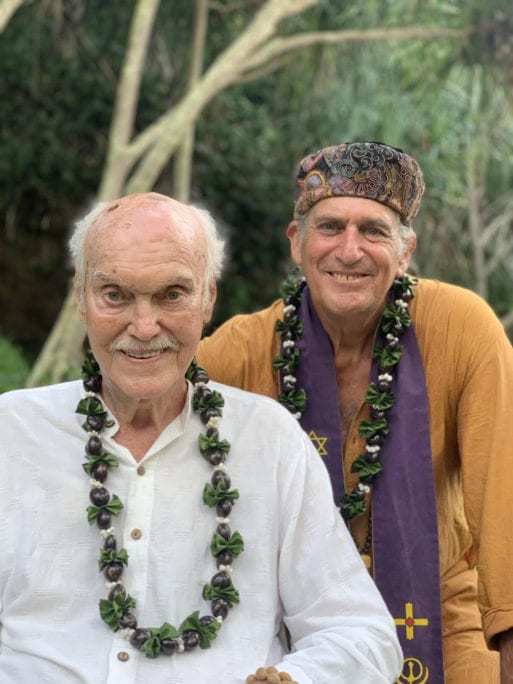
Bodhi Be (right) and spiritual leader Ram Dass, who together helped to expand awareness of the benefits of dying consciously
Credit: Bodhi Be
Be said denial of death is replete in American culture, where people view life and death as opposing forces, and the continuous consumption of goods and services seem to daily reinforce the idea that mortality can somehow be avoided.
“Death has no dignity in this culture; it has no place. You don’t see it — it’s not in the marketplace and it’s bad for business,” he said. “But when death has lost its place in the community and the community conversation, we’re not really alive. Because without death there is no life.”
In nature, he said, the two are inextricably intertwined. For example, for us to nourish our bodies and live, something else has to die. In this way it becomes easy to see that life springs from death itself. To the extent we separate ourselves from nature, we suffer unnecessarily.
“Death is a shock to us, because it proves we’re not separate from the laws of nature,” Be said. “In fact, we are nature.”
Dale Borglum, founder and executive director of the Living/Dying Project in the San Francisco Bay Area, counsels and provides spiritual support to those at end of life and their loved ones from a Buddhist perspective. A longtime associate of spiritual teacher Ram Dass and Stephen Levine, an author and teacher who wrote extensively on the topics of death and dying, Borglum focuses healing at the edge: the edge of illness, death, loss and crisis.
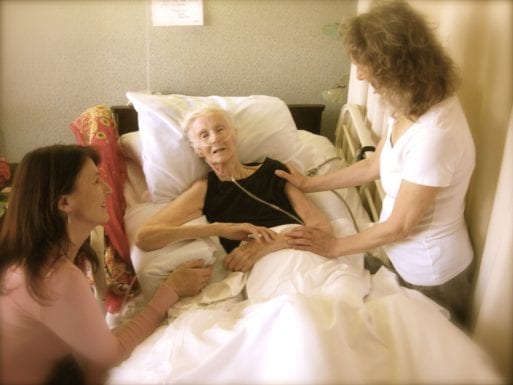
Dale Borglum of the San Francisco-area-based Living/Dying Project says the paradigm on which Western society is built assumes humans are a body and a personality. Other belief systems, however, make room for more.
Credit: Sacred Crossings
He says the paradigm on which Western society is built assumes humans are a body and a personality, and when the body dies, we die — end of story. Other belief systems, however, make room for more.
“My sense of it is that we are two-fold beings,” Borglum said. “In the material world we are born, we suffer and we die. Is there another dimension, though, that is pure consciousness, or pure God or awareness that doesn’t get old or die?”
“Conscious dying is including the second dimension but not at the expense of the first,” he continued. “We are both at the same time.”
There may not be rituals or practices that will ensure one dies consciously. But a wealth of resources exists for those who want to learn more, and for those faced with end of life who may be seeking companionship, meditation or rituals whose goal is to foster peace, reconciliation and acceptance before, during and after the time of transition.
A Conscious Movement Toward Death Acceptance
Olivia Bareham was inspired to start Sacred Crossings — which offers conscious dying workshops and death doula and midwife certification programs and runs a full-service alternative funeral home in Los Angeles — after witnessing her own mother’s death under hospice care in 2005. She was present right up until the end and, despite her physical pain, announced her readiness to go home. The sacredness of the experience continued even after her mother had died.
“The hospice nurse left, and I was invited into that liminal space,” she recalled. “I witnessed people as they walked into the door and saw their shock at seeing the body. Then, all of that fear and trepidation just dropped off as they came close, talked to her and touched her. And it became, organically, a wake.”
Much of the fear around death and dying stems from the fact that most people are not fully present for the experience, Bareham says. As conscious as her own mother’s death had been, the funeral provided a sharp contrast that is typical in Western society. Mourners are invited to take a quick look at their loved one, or even a closed casket, before the body is whisked from sight and summarily taken care of. A more communal approach allows people to be with death, to take it in and understand it as natural part of the journey of all living things.
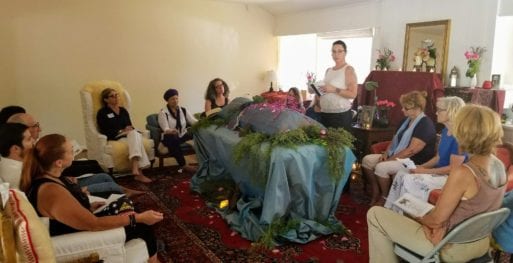
Olivia Bareham founded Sacred Crossings to help train others who could return sacred, communal practices to the dying process.
Credit: Sacred Crossings
Bareham founded Sacred Crossings to help train others who could return sacred, communal practices to the dying process. A three-part death midwifery training program begins with a lesson called “Enter the Grave,” where participants face their own personal fears around death. It’s an important first step in being able to be present for others, she said.
Many in the baby boomer generation are becoming inspired to learn about conscious dying after experiencing the loss of a parent or loved one and deciding they want something different for themselves. Others are led to the concept out of a desire to infuse the work they already do with purpose and meaning, and in that process discover a world of opportunities awaiting them.
A field once occupied primarily by a small group of pioneers who attempted to connect elevated consciousness to death acceptance has recently been growing in popularity, according to Be of Doorway Into Light. Be said the number of people seeking training to work as a death doula, midwife or coach has noticeably risen in the past few years.
“It’s an amazingly fast-growing, sexy field. There are a lot of people now in their 50s and 60s, who have had their careers but who are wanting to come back to something with more purpose,” he said. “Baby boomers have caught on to what’s still missing, sensing there’s a piece that’s not there. It’s a new movement that’s growing fast.”
The Denver-based Conscious Dying Institute aims to renew the purpose of caregiving as a spiritual practice by awakening the healing gifts of caregivers while creating rites of passage around dying that reflect the wishes and choices of patients and their families.
The institute has trained hundreds of students in a three-month death doula program that takes a deep dive into five domains of dying — physical, spiritual, practical, emotional and legacy, says Executive Director Elizabeth Padilla. The goal is to make such practices and training mainstream and available to more people.
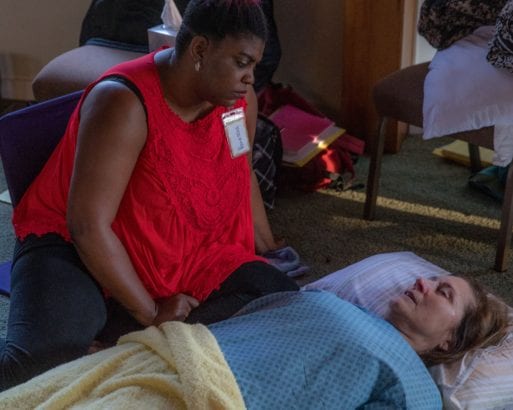
The Denver-based Conscious Dying Institute has trained hundreds of students in a three-month death doula program that takes a deep dive into five domains of dying — physical, spiritual, practical, emotional and legacy.
Credit: Conscious Dying Institute
“Our goal is to have a death doula on every hospice team and at every hospital and acute care,” Padilla said. “There are many more people who need end-of-life doulas than who know about them.”
A value in having death doulas present at end of life, she continued, is that they are often able to create a safe space for the dying while bringing their own individual gifts to bear for clients’ benefit, whether it’s a focus on healing arts, meditation, art therapy or shamanism.
“It’s really lovely when someone can share their gifts,” Padilla said. “It gives people a sense of peace and maybe a little bit of hope.”
Conscious Dying from the Bedside
Death doulas and midwives aid conscious dying not only by sitting vigil at the bedside but by establishing relationships with patients and with families that help complement medical care, whether by providing emotional support, helping arrange final wishes or assisting with after-death plans. Their presence can help a person feel more at ease, prepared and willing to make his or her transition with grace, all central aspects of conscious dying.
Tracey Walker spent decades working in the medical field before a patient’s unsatisfactory death inspired her to research ways of keeping people at end of life from falling through the cracks of Western medicine. She enrolled in a death doula training offered by Los Angeles-based Going with Grace and was so impacted by the program she continued her education in a mentorship training course.
She now lives in Grand Rapids, Michigan, where she helps train others hoping to become death doulas. The program acquaints trainees with the ins and the outs of the vocation, including advance directives and the state-by-state laws and procedures surrounding home funerals, burials and other aspects of dying. It also uses an intense meditation session during which students visualize their own deaths.

Tracey Walker enrolled in a death doula training offered by Los Angeles-based Going with Grace and now helps train others to sit with the dying.
Credit: Going with Grace
Walker believes having someone help with sometimes complicated logistics that can distract and trouble the dying and their family members frees everyone up, so they can be honestly present and enjoy final moments together.
“All of those things being taken care of means you have the time to do the spiritual and heart work with the people you love,” she said. “There’s such a connectedness and an honor and beauty to being with someone and helping them with those things — there is definitely joy in what I do.”
Gabby Jimenez, a nurse with Mission Hospice in San Mateo, California, sought death doula training through the Conscious Dying Institute before the coronavirus pandemic hit out of a desire to do more for actively dying patients. She now incorporates what she learned into her hospice work.
“One of the things I struggle with in the work that I’m doing is when someone dies, I close the door and walk away — we have to move on,” she said. “But I knew I could make a difference in these patients’ lives if I got there sooner, if I could guide them and their family in the last few months and I could help the way they grieve.”
Given her professional background, Jimenez has witnessed the final moments of thousands of individuals and said she feels privileged to be invited into the most intimate moments of her clients’ lives.
With COVID-19 pandemic guidelines largely prohibiting in-person visits, Jimenez maintains her doula practices largely through her blog “The Hospice Heart” and on Facebook, where a community of more than 52,000 followers share their thoughts and feelings and support one another.
“I see a lot of death, but what I also see is so much love and so much appreciation for the fragility of life,” she said of her calling. “While we all take last breaths, we all do it differently. I think there are a million different things that can help bring a person to that place.”
Death doulas and midwives aren’t the only ones who provide comfort and healing at the bedside for patients and family members — many people with musical backgrounds also find themselves being called upon to use their talents to assist the dying.
Bedside Harp in Langhorne, Pennsylvania, started in 2002 as a means of sharing with patients and their families the therapeutic benefits of classical harp. Founder and lifelong harpist Edie Elkan says musicians with the organization have since played at the bedsides of countless individuals and participate in harp therapy programs at various hospitals and treatment centers.
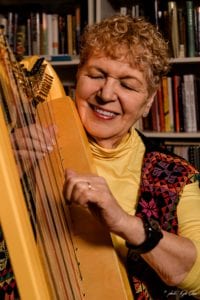
Edie Elkan founded Pennsylvania-based Bedside Harp in 2002 and has since trained more than 900 therapeutic musicians.
Credit: Bedside Harp
While popular songs may be part of a harpist’s repertoire, those who train learn special techniques for end-of-life playing, a style that is open and light. Elkan described a patient who peacefully transitioned while a player performed “The Tennessee Waltz.” A nurse later told the musician, “You had him waltzing into heaven.”
“We meet that person where they are and create a cradle of sound to envelop them or comfort them,” she said of the process. “You have to really depend on your instinct and your ability to watch everything around you.”
Monica Schley agrees. As a certified clinical musician and harpist for Seattle-based Providence Hospice, Schley provides therapeutic bedside music for patients and their loved ones as part of a care team. She said she draws on the ancient healing quality of music and uses distinct vibrations to comfort listeners.
“Music actually helps people let go, because it is so ancient and it taps into the idea that everything is vibrational,” she said.
Like Schley, those who perform at the bedside acknowledge that being present and creating a safe space for patients and families is the most integral part of the work they do, whatever their instrument.
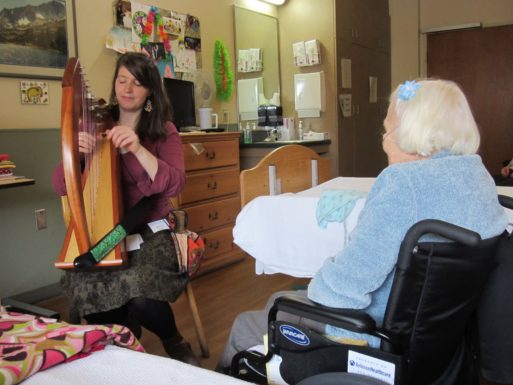
A certified clinical musician and harpist for Seattle-based Providence Hospice, Monica Schley provides therapeutic bedside music for patients
and their loved ones.
Credit: Monica Schley
A nurse for more than 33 years, Jan Booth works as an integrative nursing coach for the Conscious Dying Institute, where she trains death doulas. But she also sings alto in a Colorado chapter of the Threshold Choir, in which vocal performers sing at the bedsides of the dying, and serves as a board member for the California-based organization.
Booth said Threshold Choir members provide an “audible kindness” and a human presence to patients for whom they perform and, during practice sessions, take turns playing the role of the patient, lying on a reclining chair so each singer understands and appreciates that collective presence.
“We practice it to feel the power of what we are doing,” she said. “There is something about strangers coming into this time with only love and kindness — that, I think, is part of the beauty of it. We are all just walking each other home.”
Conscious Dying Begins Today
Although it may seem intuitive that conscious dying would begin at the end of someone’s life, Rev. Bodhi Be of Doorway Into Light says the pathway to dying consciously should ideally begin long before someone receives a terminal diagnosis.
“We have to start with conscious living,” he said. “You don’t all of a sudden become brilliant as you’re dying. Most people die as they were living. Somebody has to want to break out of their own suffering, to break out of their limited self.”
Be advises people to start on the ground floor by getting their affairs in order, so they can move on to more spiritual matters and examine parts of their own pasts where love and forgiveness may be applied. On that level, an individual can examine how they may have contributed to their problems and assess what they’ve contributed to others or the world around them.
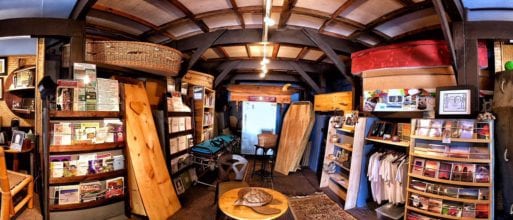
Bodhi Be and Doorway into Light opened The Death Store as an educational resource center and store for the dying, their families,
caregivers and others in 2012.
Credit: Doorway Into Light
“If you want to change your life, make the truth that we’re all going to die and we don’t know when more real to you,” he said.
Dale Borglum admitted even his Living/Dying Project isn’t so much about death as it is about the opportunity for healing that exists between living and dying. Often, people are too busy with material-world concerns to deeply examine their actions and motivations and consider what parts of them are mortal and what parts might be eternal. It’s not until a terminal diagnosis is before them that people begin the healing work that dying presents, if at all, but the chance for genuine personal growth and development is everywhere and available to all.
“Imagine what it would be like to live without fear,” Borglum said. “We can’t do that until we look at our relationship with death. The fact that death exists is an inspiration to awaken — let’s take that inspiration and die into this next moment with love. Let’s not wait until we get the bad news from the doctor.”

 “Conscious Dying” Gains Traction as Boomers Seek to Transcend a Death-Denying Culture
“Conscious Dying” Gains Traction as Boomers Seek to Transcend a Death-Denying Culture


 National Donate Life Month Reminds Us To Give
National Donate Life Month Reminds Us To Give
 How Dare You Die Now!
How Dare You Die Now!















